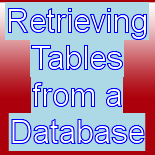Retrieving Tables from a Database
In database system it is very important to know about the tables. To work with this, it is very important to know how to retrieve a table and create a table in the database. This section provides you a facility for retrieving tables from a specific database through an example. In relational database, all the data is stored in the tabular format (rows and columns). See detail information below:
Description of program:
In this program we are establishing the connection between the MySQL database and Java file. We will retrieve the table with the help of some java methods and APIs interface. If the database has one or more tables then it shows all tables, otherwise displays the message "No any table in the database".
Description of code:
DatabaseMetaData:
This is an interface of java.sql package that implemented by
driver vendors. It tells about the data of the data like number of tables in the
database , the information about the columns of the table.
getMetaData():
It is a method of Connection interface. This method has metadata around the database and retrieves DatabaseMetaData
object.
ResultSet:
The ResultSet is an interface that provides getter methods (getBoolean,
getString, getTable and so on) for retrieving values. A ResultSet object
is by default not updatable and forward only.
getTables(null, null, "%", types):
This method returns ResultSet and takes the following
string types parameter:
catalog : Table catalog name
(may be null)
schemaPattern : Table catalog
name (may be null)
tableNamePattern : Table
name("%")
types : Table type
rs.next():
This method returns the next element of the ResultSet object.
getString("Table name"):
Above method retrieves the values from ResultSet object. It takes
string type value.
Here is the code of program:
import java.sql.*;
|
Output of program:
C:\vinod\jdbc\jdbc-mysql>javac AllTableName.java C:\vinod\jdbc\jdbc-mysql>java AllTableName Listing all table name in Database! Table name: employee employee11 employee2 employee3 employee4 employee5 employee6 employee8 employee9 java_datatypes java_datatypes2 javatypes |



